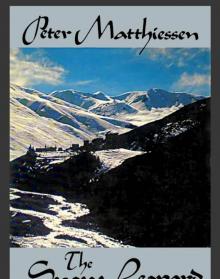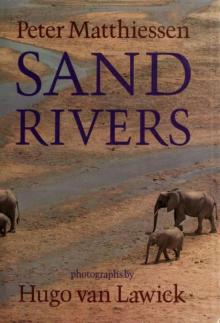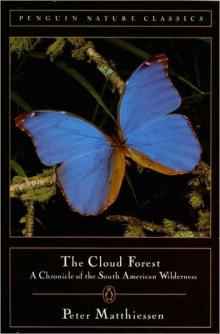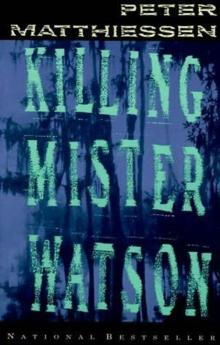- Home
- Peter Matthiessen
The Cloud Forest Page 2
The Cloud Forest Read online
Page 2
Virtually everything else one can remark about the Sargasso Sea is still a matter of dispute. Columbus, for example, was the first navigator to report it, but it has been suggested that the original discovery was made by the Phoenicians: the basis for this fascinating theory is still unknown to me. Then the origin of the sargassum weed itself remains uncertain: does it drift here from the coastal waters, or is it an indigenous pelagic plant? (It is generally agreed that Sargassum bacciferum, whatever its origins, can reproduce itself in the sea.) The weed, again, is said to swarm with littoral-type life; there is even a species of crab peculiar to it. This view is confirmed by that amazing navigator Captain Joshua Slocum, in his Sailing Alone around the World: “Sargasso, scattered over the sea in bunches, or trailed curiously along down the wind in narrow lanes, now gathered together in great fields, strange sea animals, little and big, swimming in and out, the most curious among them being a tiny sea horse which I captured and brought home preserved in a bottle.” But marine biologists in general lean toward the opposing view. In their opinion, the area is “dead water,” deficient in the nutrient salts which encourage plankton, and therefore incapable of sustaining a flourishing chain of life.
My own experience, which is all but worthless, would tend to bear out the negative point of view. It even supplies some fresh contradictions of its own. The extremities of the Horse Latitudes navigated by my ship, far from threatening to becalm us, were rudely tossed by stiff westerly winds and cresting seas. Furthermore, while sargassum weed was everywhere, it was scarcely more plentiful than in the Gulf Stream, and at no time did I spy a patch more imposing than a good-sized blanket. In a long day spent on deck I saw no animals, big or small, except the ubiquitous flying fish and a single tiny Velella, or by-the-wind sailor, a species of sea-going jellyfish which, like its relative Physalia, the Portuguese man-of-war, wanders the surface of the ocean by means of an elevated float, a kind of dorsal “sail.” The sea birds in evidence farther north had disappeared, and as for horses, I saw none.
My vantage point at the rail of a rolling freighter is scarcely an auspicious one, however, and the only scientific observation I feel qualified to confirm is that the Sargasso Sea is indeed “deep blue”; it is a vibrant, intense blue, depthless as polished stone (a fact which would seem to indicate a relative paucity of plankton communities, in case any reasonable doubt remains in this regard). And if these seas are barren, it is nevertheless true that one of the most unusual of natural histories has its start here. Far below this ship, all breeding adults of the common fresh-water eel of North America, North Africa, and Europe, arriving at unknown rates, by unknown routes, are now convening: by spring, myriad blade-shaped larvae will have hatched from eggs suspended in the murk one hundred fathoms down, and a year later (three years, in the case of the smaller European form) will enter the river mouths, ascend the streams, in the shape of elvers. There they will remain and grow, in the yellow, sluggish phase familiar to Izaak Walton, who was unable to locate their eggs or very young and who, in The Compleat Angler, reported doubtfully the opinion that they bred “out of the putrefaction of the earth, and divers other ways,” or “of a particular dew, falling in the months of May or June on the banks of some particular ponds or rivers … which in a few days are, by the sun’s heat, turned into eels.” After a period of five to twenty years these yellowish eels will change one autumn to a clean marine silver and, reversing the life process of the salmon, make their way back to the sea, to that vast backwater thousands of submarine miles away upon which now, by the hand of a mustachioed Brazilian seaman, we splash a great pail of nutrient garbage and pass on.
November 26. Bahamas Approaches.
The first fine day, blue and bright, and calm, gleaming seas. At daybreak a few whitecaps still, but these have since disappeared. The Brazilian sailors are putting up sun canvas on the frames of the afterdeck and on the bridge. These men vary in color, but most are intermediates, called morenos, and all brandish gigolos’ mustaches. They wear G.I. clothes and Levi’s as a rule, and one man has the traditional floppy peasant sombrero made of sisal. His companion, however, is rigged out for the tropics in a pair of skier’s goggles, worn jauntily on a checked logger’s cap, complete with ear flaps.
A Norwegian freighter, the Margaret Onstad, comes up on our starboard quarter and crosses close across our bows—outward bound, to judge from her present course, from Jacksonville or Fernandina to South Africa. We are presently several hundred miles due east of northern Florida.
November 27. The Caicos and Inaguas.
The Antilles Current and the Caicos Passage at first light, and a far Caribbean day expanding on the sky, the blue water sharpened by the northeast trades. Way off to the eastward, perhaps twenty miles, the Caicos Islands of the outer Bahamas, vaporish and small, rise on a silver horizon. The Caicos Islands—how many have ever seen them, for they are far off the trade and tourist routes? I savor a faint feeling of discovery.
In the next hour the islands drift forward, ever nearer the bright wake of the sun. First one, then two, as the ship’s position changes, and finally three or more—but this is an illusion, the curious mirage effect one often sees at sea. There is only one island visible, Providenciales, with considerable elevation for the Bahamas. The mass floats off mysteriously, semi-transparent in the early light like a puff of wool, and finally, directly beneath the climbing sun, goes up in fire.
No islands visible to the westward, only a huge freighter northward bound, so heavily cargoed that from this distance she appears to ride dangerously down by the head. Our own ship rolls gracefully along in the light swell; at times no other verb describes this motion.
An hour later West Caicos appears off to the eastward, and there is a dark, solitary sail. I can imagine it as if it were nearby, a heavy Bahamian fishing smack built originally, perhaps, at Man-o’-War Key in the Abacos. These ragged craft, trading, transporting, fishing for crawfish and conchs, wander everywhere in the treacherous, windy waters of the Antilles, with neither compass nor a sense of passing time.
To starboard rises the low, barren mass of Little Inagua, and about noon we come riding down upon Great Inagua, that large island north and east of Cuba. Clouds are flying across the sun, and the sea beneath is a dramatic blue-black, the color of a swordfish.
And still no birds.
In the late afternoon, approaching the Windward Passage (a name as beautiful as Tierra del Fuego), a pomarine jaeger, dark and swift, prowled our wake for nearly an hour. During this time two large porpoises of a strange café-au-lait color breached off the port quarter; they were so light that, hundreds of yards away, they were visible even under water. The splash they made was taut in the bright blue—sudden, magnificent, exciting, as if the whole silent sea had come to life. Behind the southern clouds at twilight, Haiti is looming, high and mountainous.
November 28.
At daybreak we arrived off Port-au-Prince. Mountains rose on both sides of the bay, the ridges to the eastward fired by the sun, and a soft mist shrouded the harbor and the town, which lay still in semi-darkness. Against the mist the lateen silhouettes of native sloops wavered and spun, sharp black as Japanese prints in this odd light.
A small launch rushed up out of the mist and honked officiously at the ship. The legend Capitaine du Port had been unsteadily inscribed upon its transom, and it fairly swarmed with Haitians, over half of them resplendent in varieties of official dress. A number of these dignitaries came aboard, and after a short exchange of civilities and protocol with Mr. Groen, our dignified chief steward—he may have been taken for the captain—departed once again on their tiny craft, leaving only the port pilot. The pilot conducted us back up the bay, to the float at the end of the long loading chute of the Caribbean Meal Company. Here we are scheduled to take on some four hundred and fifty tons of grain meal, for shipment to Barbados.
With my fellow passengers, an hour later, I was driven in the shipping agent’s car along the coast road to Port-au-Prince. On
our left rose scrubby foothills, and to our right lay cane-fields and small marshes, fringed by the mangrove border of the bay. Starved, scattered cattle, like survivors of some calamity, wandered aimlessly in the brake, accompanied by the cattle egret, an Old World species which, some thirty years ago, confounded ornithologists by spreading in a few swift decades from its normal haunts in Europe and North Africa to the Americas and even Australia. It has become well established in several of our Southern states, and a few have turned up in Canada and Bermuda.
In the countryside a few species of birds were relatively plentiful, including several varieties of egrets and herons, yellowlegs, kestrels, and a flock of groove-billed anis. All of these but the ani are common birds of the United States, and even the latter may be found in southern Florida. But in the outskirts of the town is a rich tropic vegetation of palms, coffee trees, hibiscus, poinsettia, flamboyant, and many others, and the only birds seen in an entire day of tourisme were a group strung from the barrel of an ancient small-caliber rifle on the ragged shoulder of a native boy, including such morsels as woodpeckers and hawks. The poverty of Port-au-Prince is awe-inspiring and may well account for the scarcity of visible life so striking here.
Port-au-Prince has a certain charm, the sort of charm which is generally described as indefinable, since there doesn’t seem much to recommend it. It is a great catch-all of hovels and unassimilated modern architecture, but there is nevertheless a cheerful, rakish air about it, with its pervasive pastels bright against a background of dark volcanic mountain.
November 29. To the Windward Passage.
This morning I got up at six to watch the completion of the loading. This grain meal, or “pollards,” is supposed to provide animal feed in Barbados, but I wonder if it isn’t really for the natives…. Disheartened by this thought, I retired after a while to the afterdeck, where I passed more than an hour observing the tropical fish around the pilings—small delicate blue tangs, yellow-tailed, swaying with the current, the swift blue knife-finned reef fishes, and squadrons of black and yellow striped sergeant majors. Farther out, where garbage from the ship has drifted, a great brown grouper, twenty pounds or more, was feeding hoggishly, like a carp, swirling clumsily on the stagnant surface, and everywhere slid needlefish, blue-tailed, and beaked like ancient marine reptiles; one of these was almost three feet long.
Leaving the pier an hour later, the Venimos retraced her inbound course, heading north-northwest up Gonaïves Gulf toward the Windward Passage. Gonave Island like a dead whale to port, and on the starboard side the dark mountainous coasts, crests shrouded in dense cumulus, loomed in oppressive contrast to a soft, slimy sea. Fish were everywhere, their movements chafing the still surface, but birds were all but absent, only an occasional royal tern; and in the distance was another pair of large brown porpoises.
The coast grows wilder as the day moves on, with sharp cliffs and buttes, and forlorn, empty bights and bays. Here and there a sagging sail, and, toward the cape, a rubble of thatch huts set back on small thin mud-gray beaches.
At the cape itself, entering the Passage and turning east again, the wind freshens with startling rapidity, and whitecaps leap up everywhere. A small sloop appears out of the north, making for land and tilting wildly in the unruly gusts. On the bow, where I spent the afternoon, it was difficult to tell the wind’s directions: a string held by the fingers flew toward the stern, obeying the ship’s passage, but, held below the level of the gunwale, it blew forward, though there seemed to be no following wind.
The north cape of Haiti, at the Windward Passage, must surely be one of the loneliest places in the world, its steep windswept slopes plunging into a deep, dark sea; one jagged rock scar, where the boulder had apparently torn away all the thin cover on its downward rush, is visible miles away.
We pass beneath the cape at sundown. It is nearly-dark now, but in the west the clouds are still touched with violet over Cuba’s Sierra Maestra. To the northeast lies the faint silhouette of the old pirate island of Tortuga.
November 30–December 2. Hispaniola, Mona Passage, and the Caribbean.
Another beautiful hot smooth day. We are four or five miles off the Dominican Republic, and Hispaniola here is still extremely mountainous, with one very high peak due southeast at eight a.m. Perfect conditions for sighting whales, porpoises, sea turtles, sharks, and billfish, but there is nothing all day, not even a solitary bird.
During the night the ship entered the Mona Passage between Hispaniola and Puerto Rico, and at daylight the former has already vanished, with Puerto Rico rising off to the north. Now we are actually in the Caribbean, and there are birds this morning, all red-footed boobies so far, but at least a dozen of these, pounding along on deep-crooked wings. A white adult dives on flying fish off to the south, quite like our northern gannet—and of course these birds are tropical members of the gannet family.
During the day the boobies are replaced by a pair of frigate birds, the so-called man-of-war birds, a red-throated male and a white-headed immature. These slide almost disdainfully across the ship, their wings, seven feet in spread, like thin bent blades, and their long tails deeply forked. In their easy, ominous flight they are among the most aerial of birds. They are replaced in their turn by jaegers, six or more, one of them in a very black phase which I have never seen before.
The stars are luminous tonight—great sprawling Orion, and red Betelgeuse, Sirius flashing like an oncoming comet, and above them, nearly overhead, Taurus, Auriga, and the lovely Pleiades.
The second of December, and the weather continues fair. No land in sight today. A few jaegers, and a distant booby. In the afternoon a whale was sighted from the bridge, but I wasn’t told of it in time to see it.
December 3. The Windward Islands.
Dominica is the northernmost of the Windward Islands, which also include Saint Lucia, Saint Vincent, and Grenada: the French islands of Guadaloupe and Martinique, which geographically are members of this group, are not considered Windward Islands by the British. Nevertheless, a French heritage is evident here, not only in the pronunciation of the name—the island is called Do-mi-ni-ca—but in the prevailing patois of the natives, most of whom speak a shy English also.
The Windward Islands were populated originally by peaceful Arawak Indians, but invasions of warlike Caribs from the region of the Amazon apparently dispossessed these people: the Caribs killed off the Arawak males and incorporated the females into their own culture. They were finally displaced in their turn by Spanish, French, and English, though not without a struggle. Dominica, in fact, was so difficult to subdue that it was left virtually alone for nearly two centuries after its discovery by Columbus in 1498. A Carib reservation still exists here, and a few Indians are scattered out among the other islands, but long ago the Caribs mixed freely with the Negro slaves, and the race has all but passed out of existence.
The capital of Dominica is Roseau, a small red-roofed town on the leeward shore, and it is visited infrequently by tourists for these reasons: as in Haiti, there is no decent beach any closer than the far side of the mountains, which are of considerable size (the largest, Mount Diablotin, is named for the nearly extinct black-capped petrel, which is thought to have nested there in the past); modern hotels and facilities are limited-to-totally-wanting—even that humble staple of the tourist, the common postcard, is hard to come by in Roseau—and finally, the tourist willing to accept these drawbacks is rewarded with exorbitant prices. He is expected to pay, it seems, for the thousands of others who have failed to put in an appearance.
All of this is too bad, for Roseau, bright and steepled against a background of deep green valleys and verdant crags—and I use the word verdant because it suits the mood of these broken volcanic summits, which a Poussin or a Watteau would quite appreciate—is a striking place. There are said to be 365 small rivers on the island, and, following one of these inland, one finds oneself in a rich tropic valley where lime, coconut, grapefruit, and banana trees are farmed commercially, and
at the head of which, where the black, cloud-shadowed peaks converge, are two high, lovely waterfalls. The vegetation includes a variety of palms, flamboyant, coffee, breadfruit, mango, eucalyptus, banyan, and poincianas—the latter the most magnificent I have ever seen. The island’s northern coast is said to be considerably more beautiful, and if this is so, then it is very beautiful indeed. Unfortunately, though the Venimos called at all the Windward Islands, one had to be satisfied with brief impressions; among the latter, for what they are worth, is that all four are quite similar geographically, but that Dominica is the most unspoiled (despite this same claim by Saint Vincent on its own behalf) and the most striking. Saint Vincent can claim the first breadfruit tree in the islands, imported from the Pacific by the Bounty’s Captain Bligh, as well as what must be the most striking view in the Windwards, obtainable from Fort Charlotte, high above the capital of Kingstown. From this fort, one of many such relics of the faraway European wars, one can see the long line of Grenadine Islands, stretching away southward toward Grenada. And it was the Grenadines, still virtually untouched, which, passing close by one lovely afternoon, most excited my curiosity. Perhaps because we did not stop there—they are largely uninhabited—I felt quite strongly that one day I would go back.
I have warm impressions of the other islands too, of the pretty little ports at Castries (Saint Lucia) and Saint George’s (Grenada), of wonderful swimming on long tropic beaches at both these places, of a school of small whales—pilot whales, or blackfish—beneath a swirl of terns and boobies, the latter sparkling white against the mountains of Saint Vincent, and of a sail in a small dinghy off Saint Lucia with my friends the radio officer, the chief engineer, and the third mate.
That these men invited me to go along is a sign of the new atmosphere of relaxation which has prevailed aboard ship since we reached the Caribbean; it may be a symptom of that “wild unbuttoning process” described by Céline as a phenomenon induced by tropic suns. The officers are outfitted in white regulation shorts, not always shipshape, and a good deal of informal rum-drinking takes place in one cabin or another of an afternoon in port.

 Lost Man's River: Shadow Country Trilogy
Lost Man's River: Shadow Country Trilogy The Tree Where Man Was Born
The Tree Where Man Was Born The Snow leopard
The Snow leopard Sand Rivers
Sand Rivers The Cloud Forest
The Cloud Forest Sal Si Puedes (Escape if You Can)
Sal Si Puedes (Escape if You Can) Far Tortuga
Far Tortuga Men's Lives
Men's Lives On the River Styx: And Other Stories
On the River Styx: And Other Stories Shadow Country
Shadow Country At Play in the Fields of the Lord
At Play in the Fields of the Lord Lost Man's River
Lost Man's River Killing Mister Watson
Killing Mister Watson On the River Styx
On the River Styx